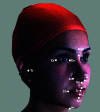Accuracy and reliability of 3D stereophotogrammetry: A comparison to direct anthropometry and 2D photogrammetry
- PMID: 26267357
- PMCID: PMC8601748
- DOI: 10.2319/041415-244.1
Accuracy and reliability of 3D stereophotogrammetry: A comparison to direct anthropometry and 2D photogrammetry
Abstract
Objective: To evaluate the accuracy of three-dimensional (3D) stereophotogrammetry by comparing it with the direct anthropometry and digital photogrammetry methods. The reliability of 3D stereophotogrammetry was also examined.
Materials and methods: Six profile and four frontal parameters were directly measured on the faces of 80 participants. The same measurements were repeated using two-dimensional (2D) photogrammetry and 3D stereophotogrammetry (3dMDflex System, 3dMD, Atlanta, Ga) to obtain images of the subjects. Another observer made the same measurements for images obtained with 3D stereophotogrammetry, and interobserver reproducibility was evaluated for 3D images. Both observers remeasured the 3D images 1 month later, and intraobserver reproducibility was evaluated. Statistical analysis was conducted using the paired samples t-test, intraclass correlation coefficient, and Bland-Altman limits of agreement.
Results: The highest mean difference was 0.30 mm between direct measurement and photogrammetry, 0.21 mm between direct measurement and 3D stereophotogrammetry, and 0.5 mm between photogrammetry and 3D stereophotogrammetry. The lowest agreement value was 0.965 in the Sn-Pro parameter between the photogrammetry and 3D stereophotogrammetry methods. Agreement between the two observers varied from 0.90 (Ch-Ch) to 0.99 (Sn-Me) in linear measurements. For intraobserver agreement, the highest difference between means was 0.33 for observer 1 and 1.42 mm for observer 2.
Conclusions: Measurements obtained using 3D stereophotogrammetry indicate that it may be an accurate and reliable imaging method for use in orthodontics.
Keywords: 3D stereophotogrammetry; Direct anthropometry; Photogrammetry.
Figures


References
-
- Ackerman JL, Proffit WR, Sarver DM. The emerging soft tissue paradigm in orthodontic diagnosis and treatment planning. Clin Orthod Res. 1999;2:49–52. - PubMed
-
- Farkas LG, Posnick JC, Hreczko TM. Anthropometric growth study of the head. Cleft Palate Craniofac J. 1992;29:303–308. - PubMed
-
- Dimaggio FR, Ciusa V, Sforza C, Ferrario VF. Photographic soft-tissue profile analysis in children at 6 years of age. Am J Orthod Dentofacial Orthop. 2007;132:475–480. - PubMed
-
- Bavbek NC, Tuncer BB, Tortop T. Soft tissue alterations following protraction approaches with and without rapid maxillary expansion. J Clin Pediatr Dent. 2014;38:277–283. - PubMed
MeSH terms
LinkOut - more resources
Full Text Sources
Other Literature Sources
Medical

